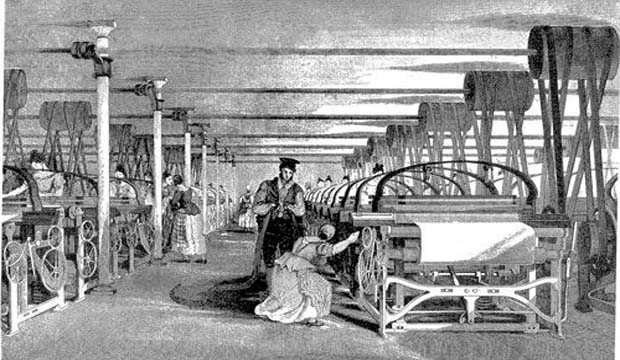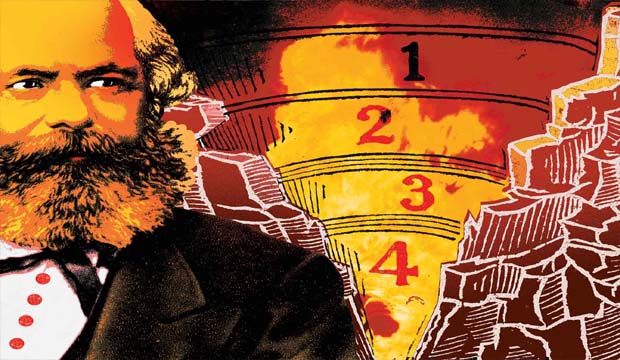
Engels’ book remains to this day, as it was in 1845, by far the best single book on the working class of the period and has been and continues to be regarded as such by subsequent historians.
 Towards the very end of his entertaining and sympathetic biography of Friedrich Engels, Tristram Hunt cites the comparison made by a Chinese scholar, Ching Kwan Lee, between the horrific working conditions in an 1840s Manchester cotton mill described by Engels in his seminal work, The Condition of the Working Class in England, and the factory experiences of a migrant worker in Shenzen 160 years later. He then points to the irony ‘that such unleavened exploitation is actively sanctioned by the Communist Party of China’.
Towards the very end of his entertaining and sympathetic biography of Friedrich Engels, Tristram Hunt cites the comparison made by a Chinese scholar, Ching Kwan Lee, between the horrific working conditions in an 1840s Manchester cotton mill described by Engels in his seminal work, The Condition of the Working Class in England, and the factory experiences of a migrant worker in Shenzen 160 years later. He then points to the irony ‘that such unleavened exploitation is actively sanctioned by the Communist Party of China’.
Engels, born 200 years ago in Barmen on November 28 to a family of wealthy cotton manufacturers, was just 24 when he wrote the book. Surrounded by the horrors of early industrial capitalism and reacting to the narrow and self-righteous mores at home, he took the usual road of progressive young German intellectuals in the late 1830s. Like his slightly older contemporary Karl Marx, he became a ‘left Hegelian’, leaning increasingly towards communism and contributing to various periodicals and publications in which the German left attempted to formulate its critique of society.
Engels left for England in the autumn of 1842, making his first personal contact with Marx on the way, and remained there for the better part of two years, observing, studying, and formulating his ideas. The book appeared in its final form in Leipzig in the summer of 1845 and was published in English, with slight revisions by the author but substantial prefaces in 1887 (American edition) and 1892 (British edition). It thus took the best part of a half-century for this masterpiece about early industrial England to reach the country which was its subject.
The idea of writing a book about the condition of the working classes was not in itself original. By the 1830s, it had become clear to every intelligent observer that the economically advanced parts of Europe faced a social problem which was no longer simply that of ‘the poor’ but of a historically unprecedented class, the proletariat. The 1830s and 40s, a decisive period in the evolution of capitalism and the working-class movement, saw books, pamphlets and inquiries into the condition of the working classes multiplying all over western Europe.
Engels’ book is the most eminent, though L. Villermé’s Tableau de l’Etat Physique et Moral des Ouvriers employés dans les Manufactures de Coton, de Laine et de Soie (Study of the Physical Condition of Cotton, Wool and Silk Workers, 1840) is a distinguished piece of social investigation. It was also clear that the problem of the proletariat was not merely local or national, but international. Buret compared English and French conditions (La misère des classes laborieuses en France et en Angleterre, 1840) and Ducpétiaux compiled data on the conditions of young workers all over Europe in 1843. Engels’ book was therefore not an isolated literary phenomenon, a fact which has led anti-Marxists periodically to accuse him of plagiarism when unable to think of anything better.
However, it differed from apparently similar contemporary works in several ways. It was, as Engels himself justly claimed, the first book in Britain or any other country which dealt with the working class as a whole and not merely with particular sections and industries. Second, and more important, it was not merely a survey of working-class conditions, but a general analysis of the evolution of industrial capitalism, of the social impact of industrialisation and its political and social consequences, including the rise of the labour movement. In fact, it was the first large-scale attempt to apply the Marxist method to the concrete study of society. However, as Engels makes clear in the 1892 preface, his books did not yet represent a mature Marxism but rather ‘one of the phases of its embryonic development’. For the mature and fully formulated interpretation, we must go to Marx’s Capital.
Argument and analysis
The work begins with a brief sketch of the industrial revolution which transformed British society and created, as its chief product, the proletariat (chapters I-II). Socially, Engels sees those transformations as a gigantic process of concentration and polarisation. In Lenin’s words ‘he was among the first to say that the proletariat is not only a class that suffers; that it is precisely its shameful economic situation which irresistibly drives it forward, and obliges it to struggle for its final emancipation’.
This inevitably leads to the growth of cities which then end up being the most typical locations of capitalism (chapter III), where unrestrained exploitation and competition appear in their most naked form, those who own no means of life and production are defeated and reduced to labouring for a pittance or to starvation when unemployed or, worse, to a life of profound insecurity, governed by the laws of capitalist competition which Engels discusses in chapter IV.
The workers’ wages fluctuate between a minimum subsistence rate, which is set by the workers’ competing with one another but limited by their inability to work below subsistence, and a maximum, set by the competition of capitalists with one another in times of labour shortage. But certain kinds of labour, notably in industry, require better-qualified workers, and their average wage level is, therefore, higher than the rest, though part of this higher level also reflects the higher cost of living in the cities. However, the competition between workers creates a permanent ‘surplus population’ – what Marx was later to call the industrial reserve army – which keeps down the standard of all.
This is so despite the expansion of the whole economy that arises from the cheapening of goods through technological progress, which increases demand and reabsorbs many of the workers it displaces into new industries, and from Britain’s industrial world monopoly. Hence population grows, production increases, and so does the demand for labour. Engels was one of the first to recognise the periodic cycles of prosperity and crisis as an integral part of capitalism.
The recognition of a reserve army as a permanent and essential part of capitalism and the trade cycle, illustrates two important aspects. Since capitalism operates through fluctuations, it must have a permanent reserve of workers, except at the very peak of the booms. The reserve is composed partly of proletarians, partly of potential proletarians – countrymen, Irish immigrants, people from economically less dynamic occupations.
The innards of capitalism
What kind of working class does capitalism produce? What are its conditions of life, what sort of individual and collective behaviour do these material conditions create? Engels devotes the greater part of his book (chapters III, V-XI) to the description and analysis of these matters and in doing so produces his most mature contribution to social science, an analysis of the social impact of capitalist industrialisation and urbanisation which is still in many respects unsurpassed. It must be read and studied in detail. The argument can be briefly summarised as follows.
Capitalism pitchforks the new proletariat, often composed of immigrants from pre-industrial backgrounds, into a social hell in which they are ground down, underpaid or starved, left to rot in slums, neglected, despised, and coerced, not only by the impersonal force of competition but by the bourgeoisie as a class, which regards them as objects and not as men, as ‘labour’ or ‘hands’ and not as human beings (chapter XII). The capitalist, supported by bourgeois law, imposes his factory discipline, fines them, causes them to be jailed, imposes his wishes on them at will.
The workers face their situation in different ways. Some succumb, others submit passively, take no interest in public affairs and thus actually help the middle class to tighten the chains. Real humanity and dignity are to be found only in the labour movement which passes through various stages. Individual revolt does occur but trade unions and strikes are the first general forms, important for the lessons of solidarity and class consciousness which they teach. The political movement of Chartism marks a higher level of development. Socialist theories also evolved side by side.
As Engels saw in 1844 this crisis would inevitably develop in one of two ways. Either American (or possibly German) competition would put an end to British industrial monopoly and precipitate a revolutionary situation, or the polarisation of society would proceed until the workers, by then the great majority of the nation, would realise their strength and seize power. However, given the intolerable conditions of the workers and the economic crisis, he felt a revolution was likely to occur between the next two economic depressions, i.e. between 1846-7 and the middle 1850s.
At the time Engels wrote, British capitalism was at the peak of its secular crisis, and he came to England at the worst period of what was certainly the most catastrophic economic slump of the 19th century, 1841-2.
We now know that this was not the final crisis of capitalism, but the prelude to a major period of expansion, based partly on the massive development of capital goods industries – railways, iron and steel, as against textiles in the earlier phase – partly on the conquest of yet wider spheres of capitalist activity in hitherto undeveloped countries, partly on the defeat of the agrarian vested interests, partly on the discovery of new and effective methods of exploiting the working classes which, incidentally, made it possible eventually for their real incomes to rise substantially.
We also know that the revolutionary crisis of 1848, which Engels foresaw with considerable accuracy, did not affect Britain. This was largely due to a phenomenon of uneven development, which he could hardly have foreseen. For while on the continent, the corresponding stage of economic development reached its most acute crisis in 1846-8, in Britain the equivalent point had been reached in 1841-2. By 1848 the new period of expansion, whose first symptom was the vast ‘railway boom’ of 1844-7, was already underway.
The British equivalent of the 1848 revolution was the Chartist general strike of 1842. The crisis which precipitated continental revolutions, in Britain merely interrupted a period of rapid recovery. Engels happened to be particularly unfortunate to be writing at a time when this could not be clear. Even today statisticians still argue about exactly where, between 1842 and 1848, to place the divider that separates the ‘bleak years’ from the golden Victorian boom of British capitalism. We can hardly blame Engels for not seeing it more clearly.
The unbiased reader thus regards the shortcomings of Engels’ book as incidental, and is far more impressed with its achievements. These were due not only to Engels’ obvious personal talent, but also to his communist world view. It was this which gave him an economic, social and historical perspicacity superior to the contemporary champions of capitalism. The good social scientist, as Engels showed, could only be a person free from the illusions of bourgeois society.
Standing up to scrutiny
How far is Engels’ description of the British working class in 1844 reliable and comprehensive? How far has subsequent research confirmed his statements? Our judgement of the historical value of the book must depend largely on the answer to these questions. He has often been criticised, from the 1840s, when V.A. Huber and B. Hildebrand agreed with his facts, but thought his interpretation too gloomy, to the Cold War years when editors argued that ‘historians may no longer regard Engels’ book as an authoritative work which gives a valuable picture of social England in the 1840s’. The first view is tenable, the second is nonsense.
Engels’ account is based on first-hand observation and on other available sources, He knew industrial Lancashire intimately, particularly the Manchester area, paid visits to the main industrial towns of Yorkshire – Leeds, Bradford, Sheffield – and also spent some weeks in London. Nobody has seriously suggested that he misrepresented what he saw. Of the descriptive chapters, it is clear that a large part of III, V, VII, IX and XII are based on first-hand observation, and such knowledge plainly illuminates the other chapters also.
It must not be forgotten that Engels was (unlike most other foreign visitors) no mere tourist, but a Manchester businessman who knew his milieu, a communist who knew and worked with the Chartists and early socialists, and, not least through his relations with the Irish factory girl Mary Burns and her relatives and friends, a man with considerable first-hand knowledge of working-class life. His book is thus an important primary source for our knowledge of industrial England at this time.
For the rest of the book, and for confirmation of his own observations, Engels relied on other sources. Though not exhaustive, his documentation is good and full. Though there are a number of slips in transcribing and a tendency to summarise, the accusation that he selects and misquotes his evidence is untenable. His hostile editors have been unable to find more than a handful of examples of what they consider ‘misrepresentation’ in a large volume, and most of these accusations are either trivial or wrong. By all sensible standards, the Condition is an excellently documented work.
Accusations that he painted proletarian conditions in unnecessarily dark colours or failed to appreciate the benevolence of the British bourgeoisie can be shown to be wrong. He did not deny that improvements in working-class conditions had been made ( summary at the end of chapter III). He did not present the bourgeoisie as a single black-hearted mass ( long footnote at the end of chapter XII). His hatred of what the bourgeoisie represented and what made it behave as it did was part of the critique of the inhumanity of capitalism which automatically turned the exploiters collectively into a ‘deeply demoralized class, incurably corrupted by selfishness, corroded in their very being’.
The truth is that Engels’ book remains today, as it was in 1845, by far the best single book on the working class of the period. Subsequent historians have regarded and continue to regard it as such, except for a recent group of critics, motivated by ideological dislike. It is not the last word on the subject, for 175 years of research have added to our knowledge, especially in the areas with which Engels had no close personal acquaintance. It is a book of its time. But nothing can take its place in the library of every 19th century historian and everyone interested in the working-class movement. It remains an indispensable work and a landmark in the fight for the emancipation of humanity.
COurtesy The Wire














